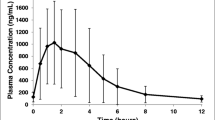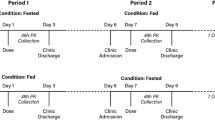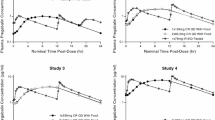Abstract
Objective
To determine the single- and multiple-dose pharmacokinetic profile of gepirone extended-release (ER) in healthy individuals.
Methods
The single- and multiple-dose pharmacokinetics of gepirone-ER were investigated in three randomised, placebo-controlled studies of 115 healthy subjects. Dosages ranged from 10 to 75 mg/day for 6 days (study 1), 20 mg/day for 7 days (study 2), and 120 mg/day for 7 days (study 3). Blood samples were obtained to measure plasma levels of gepirone and the l-pyrimidinyl-(2-pipera-zine) [1-PP] metabolite prior to the first dose and other intervals on the first and last treatment days. Pharmacokinetic parameters included peak plasma level (Cmax), time to peak plasma level (tmax), and area under the concentration-time curve (AUC).
Results
In single-dose studies, peak gepirone-ER plasma concentrations were reached in approximately 4 to 5 hours and slowly declined over the next 20 hours. Steady-state plasma gepirone concentrations were reached by day 2 during multiple-dose studies; Cmax, minimum trough plasma concentration (Cmin) and AUC were dose proportional. Greater fluctuations in plasma concentrations were observed with gepirone solution than with gepirone-ER. The AUC for gepirone-ER was approximately 80% of that for gepirone solution. A similar pharmaco-kinetic profile was observed for the 1-PP metabolite. Gepirone-ER was generally well tolerated at all doses in all age groups except for 120 mg/day. The incidence of adverse events, including headache, dizziness and nausea, tended to be higher in gepirone-ER than in placebo recipients.
Conclusions
Gepirone and 1-PP exhibited linear pharmacokinetic profiles. Peak/trough fluctuations in plasma gepirone concentrations were reduced by gepirone-ER, while total exposure to drug (AUC) was maintained. Overall, gepirone-ER was well tolerated. As a result of lower peak plasma levels, gepirone-ER may be expected to reduce the incidence of adverse events compared with gepirone immediate-release and thus has the potential to improve response.






Similar content being viewed by others
References
Blier P, de Montigny C. Modification of 5-HT neuron properties by sustained administration of the 5-HT1A agonist gepirone: electrophysiological studies in the rat brain. Synapse 1987; 1: 470–80
Tay LK, Sciacca MA, Sostrin MB, et al. Effect of food on the bioavailability of gepirone in humans. J Clin Pharmacol 1993; 33(7): 631–5
Tay LK, Farmen RH, Pittman KA. Pharmacokinetics (PH) and disposition of gepirone (GEP) and 1-pyrimidinylpiperazine (1-PP) in humans after intravenous (i.v.) and oral (p.o.) administration of 14C-gepirone [abstract]. Pharm Res 1990; 7(9 Suppl. ): S208
Blier P, Curet O, Chaput Y, et al. Tandospirone and its metabolite, l-(2-pyrimidinyl)-piperazine: II. Effects of acute administration of 1-PP and long-term administration of tandospirone on noradrenergic neurotransmission. Neuro-pharmacology 1991; 30(7): 691–701
Miller LG, Thompson MI, Byrnes JJ, et al. Kinetics, brain uptake, and receptor binding of tandospirone and its metabolite l-(2-pyrimidinyl)-piperazine. J Clin Psychopharmacol 1992; 12: 341–5
Rimele TJ, Henry DE, Lee DK, et al. Tissue-dependent alpha adrenoceptor activity of buspirone and related compounds. J Pharmacol Exp Ther 1987; 241(3): 771–8
Giral P, Soubrie P, Puech AJ. Pharmacological evidence for the involvement of l-(2-pyridinyl)-piperazine (1-PmP) in the interaction of buspirone or gepirone with noradrenergic systems. Eur J Pharmacol 1987; 134(1): 113–6
Gobbi M, Frittoli E, Mennini T. Antagonist properties of l-(2-pyrimidinyl)piperazine at presynaptic alpha 2-adrenoceptors in the rat brain. Eur J Pharmacol 1990; 180(1): 183–6
Gibaldi M, Perrier D. Noncompartmental analysis based on statistical moment theory. Pharmacokinetics. 2nd ed. New York: Marcel Dekker, 1982: 409–17
Fitton A, Benfield P. Gepirone in depression and anxiety disorders. CNS Drugs 1994; 1: 388–98
Author information
Authors and Affiliations
Corresponding author
Rights and permissions
About this article
Cite this article
Timmer, C.J., Sitsen, J.M.A. Single- and Multiple-Dose Pharmacokinetics and Tolerability of Gepirone Extended-Release. Clin. Drug Investig. 22, 819–826 (2002). https://doi.org/10.2165/00044011-200222120-00002
Published:
Issue Date:
DOI: https://doi.org/10.2165/00044011-200222120-00002




